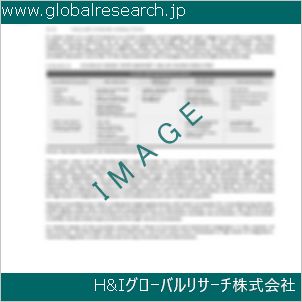Table of Contents
1 Industry Overview of Lanthanum
1.1 Definition and Specifications of Lanthanum
1.1.1 Definition of Lanthanum
1.1.2 Specifications of Lanthanum
1.2 Classification of Lanthanum
1.3 Applications of Lanthanum
1.3.1 Nuclear Application
1.3.2 Non-Nuclear Application
1.4 Industry Chain Structure of Lanthanum
1.5 Industry Overview and Major Regions Status of Lanthanum
1.5.1 Industry Overview of Lanthanum
1.5.2 Global Major Regions Status of Lanthanum
1.6 Industry Policy Analysis of Lanthanum
1.7 Industry News Analysis of Lanthanum
2 Manufacturing Cost Structure Analysis of Lanthanum
2.1 Raw Material Suppliers and Price Analysis of Lanthanum
2.2 Equipment Suppliers and Price Analysis of Lanthanum
2.3 Labor Cost Analysis of Lanthanum
2.4 Other Costs Analysis of Lanthanum
2.5 Manufacturing Cost Structure Analysis of Lanthanum
2.6 Manufacturing Process Analysis of Lanthanum
3 Technical Data and Manufacturing Plants Analysis of Lanthanum
3.1 Capacity and Commercial Production Date of Global Lanthanum Major Manufacturers in 2023
3.2 Manufacturing Plants Distribution of Global Lanthanum Major Manufacturers in 2023
3.3 R&D Status and Technology Source of Global Lanthanum Major Manufacturers in 2023
3.4 Raw Materials Sources Analysis of Global Lanthanum Major Manufacturers in 2023
4 Capacity, Production and Revenue Analysis of Lanthanum by Regions, Types and Manufacturers
4.1 Global Capacity, Production and Revenue of Lanthanum by Regions 2019-2024
4.2 Global and Major Regions Capacity, Production, Revenue and Growth Rate of Lanthanum 2019-2024
4.3 Global Capacity, Production and Revenue of Lanthanum by Types 2019-2024
4.4 Global Capacity, Production and Revenue of Lanthanum by Manufacturers 2019-2024
5 Price, Cost, Gross and Gross Margin Analysis of Lanthanum by Regions, Types and Manufacturers
5.1 Price, Cost, Gross and Gross Margin Analysis of Lanthanum by Regions 2019-2024
5.2 Price, Cost, Gross and Gross Margin Analysis of Lanthanum by Types 2019-2024
5.3 Price, Cost, Gross and Gross Margin Analysis of Lanthanum by Manufacturers 2019-2024
6 Consumption Volume, Consumption Value and Sale Price Analysis of Lanthanum by Regions, Types and Applications
6.1 Global Consumption Volume and Consumption Value of Lanthanum by Regions 2019-2024
6.2 Global and Major Regions Consumption Volume, Consumption Value and Growth Rate of Lanthanum 2019-2024
6.3 Global Consumption Volume and Consumption Value of Lanthanum by Types 2019-2024
6.4 Global Consumption Volume and Consumption Value of Lanthanum by Applications 2019-2024
6.5 Sale Price of Lanthanum by Regions 2019-2024
6.6 Sale Price of Lanthanum by Types 2019-2024
6.7 Sale Price of Lanthanum by Applications 2019-2024
6.8 Market Share Analysis of Lanthanum by Different Sale Price Levels
7 Supply, Import, Export and Consumption Analysis of Lanthanum
7.1 Supply, Consumption and Gap of Lanthanum 2019-2024
7.2 Global Capacity, Production, Price, Cost, Revenue, Supply, Import, Export and Consumption of Lanthanum 2019-2024
7.3 USA Capacity, Production, Price, Cost, Revenue, Supply, Import, Export and Consumption of Lanthanum 2019-2024
7.4 EU Capacity, Production, Price, Cost, Revenue, Supply, Import, Export and Consumption of Lanthanum 2019-2024
7.5 China Capacity, Production, Price, Cost, Revenue, Supply, Import, Export and Consumption of Lanthanum 2019-2024
7.6 Japan Capacity, Production, Price, Cost, Revenue, Supply, Import, Export and Consumption of Lanthanum 2019-2024
8 Major Manufacturers Analysis of Lanthanum
8.1 Manufacturer One
8.1.1 Company Profile
8.1.2 Product Picture and Specifications
8.1.2.1 Type I
8.1.2.2 Type II
8.1.2.3 Type III
8.1.3 Capacity, Production, Price, Cost, Gross and Revenue
8.1.4 Contact Information
8.2 Manufacturer Two
8.2.1 Company Profile
8.2.2 Product Picture and Specifications
8.2.2.1 Type I
8.2.2.2 Type II
8.2.2.3 Type III
8.2.3 Capacity, Production, Price, Cost, Gross and Revenue
8.2.4 Contact Information
8.3 Manufacturer Three
8.3.1 Company Profile
8.3.2 Product Picture and Specifications
8.3.2.1 Type I
8.3.2.2 Type II
8.3.2.3 Type III
8.3.3 Capacity, Production, Price, Cost, Gross and Revenue
8.3.4 Contact Information
8.4 Manufacturer Four
8.4.1 Company Profile
8.4.2 Product Picture and Specifications
8.4.2.1 Type I
8.4.2.2 Type II
8.4.2.3 Type III
8.4.3 Capacity, Production, Price, Cost, Gross and Revenue
8.4.4 Contact Information
8.5 Manufacturer Five
8.5.1 Company Profile
8.5.2 Product Picture and Specifications
8.5.2.1 Type I
8.5.2.2 Type II
8.5.2.3 Type III
8.5.3 Capacity, Production, Price, Cost, Gross and Revenue
8.5.4 Contact Information
…
9 Marketing Trader or Distributor Analysis of Lanthanum
9.1 Marketing Channels Status of Lanthanum
9.2 Traders or Distributors with Contact Information of Lanthanum by Regions
9.3 Ex-work Price, Channel Price and End Buyer Price Analysis of Lanthanum
9.4 Regional Import, Export and Trade Analysis of Lanthanum
10 Industry Chain Analysis of Lanthanum
10.1 Upstream Major Raw Materials Suppliers Analysis of Lanthanum
10.1.1 Major Raw Materials Suppliers with Contact Information Analysis of Lanthanum
10.1.2 Major Raw Materials Suppliers with Supply Volume Analysis of Lanthanum by Regions
10.2 Upstream Major Equipment Suppliers Analysis of Lanthanum
10.2.1 Major Equipment Suppliers with Contact Information Analysis of Lanthanum
10.2.2 Major Equipment Suppliers with Product Pictures Analysis of Lanthanum by Regions
10.3 Downstream Major Consumers Analysis of Lanthanum
10.3.1 Major Consumers with Contact Information Analysis of Lanthanum
10.3.2 Major Consumers with Consumption Volume Analysis of Lanthanum by Regions
10.4 Supply Chain Relationship Analysis of Lanthanum
11 Development Trend of Analysis of Lanthanum
11.1 Capacity, Production and Revenue Forecast of Lanthanum by Regions and Types
11.1.1 Global Capacity, Production and Revenue of Lanthanum by Regions 2024-2029
11.1.2 Global and Major Regions Capacity, Production, Revenue and Growth Rate of Lanthanum 2024-2029
11.1.3 Global Capacity, Production and Revenue of Lanthanum by Types 2024-2029
11.2 Consumption Volume and Consumption Value Forecast of Lanthanum by Regions, Types and Applications
11.2.1 Global Consumption Volume and Consumption Value of Lanthanum by Regions 2024-2029
11.2.2 Global and Major Regions Consumption Volume, Consumption Value and Growth Rate of Lanthanum 2024-2029
11.2.3 Global Consumption Volume and Consumption Value of Lanthanum by Types 2024-2029
11.2.4 Global Consumption Volume and Consumption Value of Lanthanum by Applications 2024-2029
11.3 Supply, Import, Export and Consumption Forecast of Lanthanum
11.3.1 Supply, Consumption and Gap of Lanthanum 2024-2029
11.3.2 Global Capacity, Production, Price, Cost, Revenue, Supply, Import, Export and Consumption of Lanthanum 2024-2029
11.3.3 USA Capacity, Production, Price, Cost, Revenue, Supply, Import, Export and Consumption of Lanthanum 2024-2029
11.3.4 EU Capacity, Production, Price, Cost, Revenue, Supply, Import, Export and Consumption of Lanthanum 2024-2029
11.3.5 China Capacity, Production, Price, Cost, Revenue, Supply, Import, Export and Consumption of Lanthanum 2024-2029
11.3.6 Japan Capacity, Production, Price, Cost, Revenue, Supply, Import, Export and Consumption of Lanthanum 2024-2029
12 New Project Investment Feasibility Analysis of Lanthanum
12.1 New Project SWOT Analysis of Lanthanum
12.2 New Project Investment Feasibility Analysis of Lanthanum
13 Conclusion of the Global Lanthanum (CAS 7439-91-0) Industry 2024 Market Research Report
| ※参考情報 ランタン(La)は、周期表の第57番目の元素であり、希土類元素の一つとして分類されています。化学記号はLaで、原子量は138.904です。ランタンは軽く、シルバーグレーの金属であり、空気中で酸化しやすいため、通常は酸化物の形で存在します。この元素の特性や利用方法、関連技術について詳述します。 ランタンの特徴として、まずその物理的性質が挙げられます。ランタンは柔らかく、切削や加工が容易であり、金属的な光沢を持っています。また、融点は920°C、沸点は3464°Cであり、高温に耐える性質を持っています。しかし、酸化物の形で扱われていることが多く、自然界においては主にモンツクロサイト鉱石などの鉱石の中に存在しています。 化学的には、ランタンは三価の陽イオン(La³⁺)として安定であり、強い還元力を持つことから他の元素と反応しやすい性質があります。また、電子配置が特異であり、4f電子が関与することで特異な磁気的性質を示します。こうした性質により、ランタンは多くの化学反応に参加しやすく、さまざまな化合物を形成します。 ランタンには多種多様な用途が存在します。主な用途としては、照明器具やバッテリー、触媒としての役割が挙げられます。特に、ランタンはランタン電池へ使用され、ニッケル水素電池やリチウムイオン電池の材料としても使用されることが増えています。また、ランタン化合物は高温超伝導体やセラミックス、ガラス製品の添加剤として活用されます。これにより、素材の強度や耐久性が向上し、工業製品の品質向上に寄与しています。 光学産業においても、ランタンは重要な役割を果たしています。例えば、ランタンは光学ガラスやレンズの製造に際して、屈折率を高めるための材料として使用されます。また、フラッシュライトやカメラのストロボなどで使用されるフラッシュコンデンサーにも利用されています。これにより、高品質な光源が提供され、写真撮影や映像制作において優れた成果を上げることができるのです。 さらに、ランタンは医療分野でも注目されています。特に放射線治療において、ランタンを使用した放射線療法が研究されています。これにより、がん細胞をターゲットにした治療法が開発され、より効果的な治療が期待されています。 環境への配慮からも、ランタンを活用した技術は進展しています。例えば、ランタンを触媒として使用することで、排出ガスの浄化が図られています。自動車の排気系統に利用される触媒コンバーターや、化学工業においては反応速度を向上させるための触媒としても重用されます。これにより、環境負荷の低減が実現されており、持続可能な社会の実現に向けた取り組みが進んでいます。 また、ランタンを含む合金は、航空宇宙や自動車産業で軽量化や強度向上を目的として利用されています。特に、アルミニウムやマグネシウムとの合金は、軽量化が求められる分野での材料として注目されています。これにより、燃費向上や運搬コストの削減に寄与することが期待されています。 一方で、ランタンの採取や加工には注意が必要です。希土類元素であるため、環境への影響や資源の枯渇についての議論もされています。特に、採掘時の環境への影響や廃棄物処理に関する技術開発が求められています。リサイクル技術の向上が今後の課題となるでしょう。 以上のように、ランタンは多岐にわたる分野で重要な役割を果たす元素であり、その特性や用途、関連技術についての理解が進むことで、今後もさらなる活用が期待されます。ランタンを用いた技術の革新は、持続可能な社会の実現や新たな産業の発展に寄与することでしょう。ランタンの特性や用途に関する研究は今後も続き、多様な可能性が広がることが期待されます。 |
❖ 免責事項 ❖
http://www.globalresearch.jp/disclaimer












